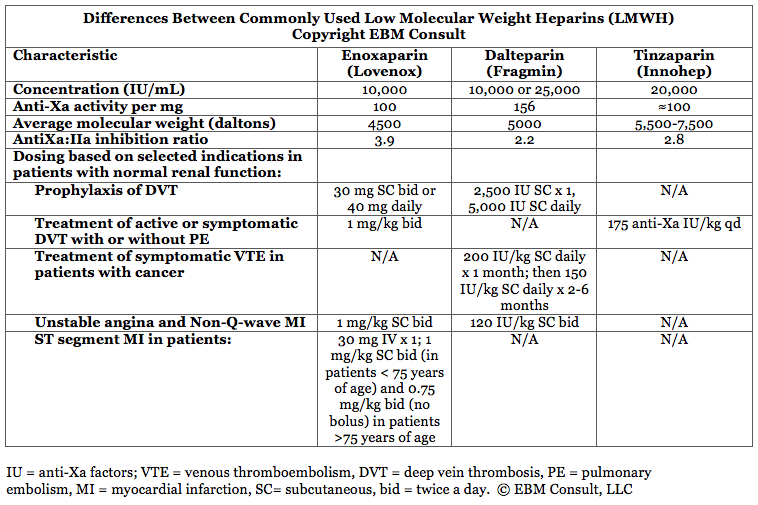Low
molecular weight heparins (LMWH) are used for a variety of cardiovascular
conditions and offer many advantages over traditional unfractionated heparin
(UFH). The three most commonly prescribed LMWH are enoxaparin (Lovenox),
dalteparin (Fragmin) and tinzaparin (Innohep) of which enoxaparin is most
commonly used in clinical practice.1-3 While the ultimate choice of which
LMWH to use may be influenced by the approved indication, the ease of use and
dosing are also important factors in clinician acceptance. As such, if a
medication is complicated to prescribe, dispense and/or administer, then
healthcare systems and clinicians are likely to perceive an increase in risk
for human error. This is especially true if a medication's dose falls outside
of the normal medical nomenclature recognized by most healthcare providers and
if the drug requires more than one mathematical calculation to be performed
prior to dispensing and/or administration. While LMWH do offer many
benefits over UFH, their dosing can appear complicated or confusing to many
clinicians.
The
dosing of all LWMHs is based on the amount of inhibition of Xa and IIa and is
commonly reported as the anti-Xa:anti-IIa activity ratio.1-4 This ratio
was established by the World Health Organization First International Low
Molecular Weight Heparin Reference Standards and reflects the differences
between the individual LMWHs. As such, the LMWH are not interchangeable
and require significantly different doses to elicit similar effects.
Specifically, enoxaparin is dosed in milligrams (mg) or mg per kilogram (kg)
while dalteparin and tinzaparin are dosed in IU (international units) or IU per
kg.1-3 To further complicate the issue, the IU actually designates anti-Xa
activity. Since most medications are dosed in micrograms (mcg), mg, or
mg/kg, it stands to reason that clinicians may not be as familiar or
comfortable with prescribing medications that deviate from this standard.
When considering the dose or a therapeutic interchange between the LMWHs, a
clinician would first have to recognize what an IU or anti-Xa activity was and
then know how to use that information to possibly perform a series of
calculations to determine the volume of drug to be administered. Most
clinicians recognize that any time more steps are required for the correct
prescribing, dispensing and administration of a drug, the greater the chance of
error.

How, then, was enoxaparin able to be marketed using mg and
mg per kg dosing, which is more readily recognized by all practicing healthcare
providers?
The
answer is found in the original designation of its pharmacological activity and
its ability to be easily converted to traditional nomenclature. As noted
in the table below, the concentration of enoxaparin is 10,000 IU per 1 mL. It
just so happens that 10 mg of enoxaparin inhibits 1000 IU (or anti-Xa units)
and thus works out to be 1 mg of enoxaparin inhibits 100 anti-Xa units.
As such, the treatment doses for enoxaparin are essentially 100 IU or 100
anti-Xa units per kg subcutaneously every 12 hours. This can be converted
to 1 mg per kg SC every 12 hours which is much easier for the clinician to recognize,
remember, prescribe and even administer. Unfortunately, dalteparin and
tinzaparin are not as easily converted to a mg strength which can be further
standardized with nomenclature that most clinicians recognize. In
addition, not only does a clinician have to calculate the number of IU to give
based on the patient's weight, but the clinician will still have to convert
that number if IU or anti-Xa units to a specific volume of medication to
administer.
Therefore,
the easy conversion and representation of the anti-Xa activity of enoxaparin
works in its favor in terms of ease of prescribing, dosing, dispensing and
administration. It is of significant importance that all healthcare
providers recognize that LMWH are not interchangeable and the dosing used for
one LMWH is clearly not the same for other LMWH.
References:
- Enoxaparin (Lovenox) product package insert. Sanofi-Aventis LLC. Bridgewater, NJ. 2008.
- Dalteparin (Fragmin) product package insert. Pfizer Inc. New York, NY. April 2007.
- Tinzaparin (Innohep) product package insert. DuPont Pharma. Wilmington, DE. July 2000.
- Kaul
S, Shah PK. Low molecular weight heparin in acute coronary syndrome:
evidence for superior or equivalent efficacy compared with
unfractionated heparin. J Am Coll Cardiol 2000;35:1699-712.


